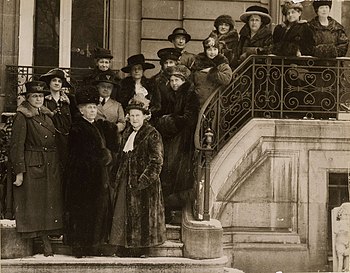
Back مؤتمر النساء بين الحلفاء Arabic Conferência Interaliada das Mulheres Portuguese 国际联盟妇女大会 Chinese

The Inter-Allied Women's Conference (also known as the Suffragist Conference of the Allied Countries and the United States)[Note 1] opened in Paris on 10 February 1919. It was convened parallel to the Paris Peace Conference to introduce women's issues to the peace process after the First World War. Leaders in the international women's suffrage movement had been denied the opportunity to participate in the official proceedings several times before being allowed to make a presentation before the Commission on International Labour Legislation. On 10 April, women were finally allowed to present a resolution to the League of Nations Commission. It covered the trafficking and sale of women and children, their political and suffrage status, and the transformation of education to include the human rights of all persons in each nation.
Though the women involved failed to achieve many of their aims, their efforts marked the first time that women were allowed to participate formally in an international treaty negotiation. They were successful in gaining the right for women to serve in the League of Nations in all capacities, whether as staff or delegates; and in gaining adoption of their provisions for humane labour conditions and the prevention of trafficking. The fact that the women were allowed to participate in the formal peace conference validated women's ability to take part in international policy-making and globalised the discussion of human rights.
- ^ Finch 1919, p. 186.
- ^ The Guardian 1919b, p. 9.
Cite error: There are <ref group=Note> tags on this page, but the references will not show without a {{reflist|group=Note}} template (see the help page).
© MMXXIII Rich X Search. We shall prevail. All rights reserved. Rich X Search